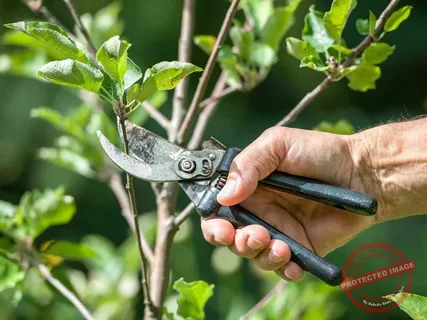If you’ve ever stepped into your yard after a long summer and spotted ugly brown blotches across your once-green carpet of grass, you know that sinking feeling. It’s like watching your hard work fade right before your eyes. The sprinklers ran all summer, you fertilized, you mowed, and still — there it is. A patch that looks dead, dry, and hopeless.
I’ve had my share of those moments. Some years, I blamed the heat. Other years, I blamed pests or the neighbor’s dog. But one thing I’ve learned over time is this: brown patches don’t just appear out of nowhere. They’re your lawn’s way of asking for help.
Autumn is a season of second chances. Sure, it’s when the days grow shorter, but it’s also when the soil cools, roots grow stronger, and your lawn starts preparing for its long winter nap. If you act now, before the frost hits, you can bring those brown patches back to life — and save yourself a lot of work come spring.
Let’s talk about how to do that step by step, with real, hands-on methods that actually work.
Step 1: Figure Out Why It Happened
Every brown patch tells a story. The trick is reading it right. Some patches are caused by lack of water; others come from too much water. Then there are those sneaky culprits — grubs, chinch bugs, and burns pest — that quietly chew at your grass roots until the green fades away.
I like to do a quick tug test. Grab a small handful of brown grass and pull gently. If it lifts up easily, the roots are probably gone — likely from pests or rot. But if it stays firm in the soil, the issue may be dehydration, thatch buildup, or soil compaction.
A magnifying glass helps, too. You’d be surprised how often you’ll spot tiny insects crawling around the base of the grass blades. Burns pest, for example, often leave faint black spots or chewed stems behind. Once you know what you’re dealing with, you can treat it properly instead of guessing.
Step 2: Aerate the Compacted Soil
Compacted soil is one of the most common reasons for brown patches. Over time, foot traffic, mowing, and rain press the soil down so tightly that air, water, and nutrients can’t reach the roots.
That’s where aeration comes in. You can rent a core aerator, or just use a garden fork if your lawn’s small. Push it into the ground about three inches deep and twist slightly to create small holes. When I first started farming, I used to think this was unnecessary “extra” work. But one fall, after aerating for the first time, I noticed my grass came back thicker and greener than it had been in years.
After aeration, water deeply. The soil should drink it up like a sponge. If puddles form, that means your soil’s still too compacted — keep working it loose over time.
Step 3: Feed Your Lawn the Right Way
Just like people, grass needs food to heal. The right feeding makes all the difference between a patch that limps into winter and one that thrives again by spring.
For fall feedings, I like to use organic fertilizers or compost instead of heavy synthetic ones. A mix with low nitrogen but plenty of phosphorus and potassium works best — it strengthens the roots rather than pushing weak top growth.
You can also brew up compost tea. It’s like an energy drink for your soil — full of microbes that rebuild soil structure and fight off disease. I remember one year when a large brown patch near my barn refused to green up. I drenched it with compost tea every few days for two weeks. Within a month, tiny green shoots began peeking through again.
If your soil’s poor, mix in aged manure or leaf compost. You don’t need to go fancy; your lawn just needs a steady source of organic matter to restore life underground.
Step 4: Reseed or Overseed Bare Spots
This is the part where patience pays off. Reseeding gives your lawn a fresh start — new roots, new strength. The trick is timing and soil contact.
Pick a seed variety that matches your existing grass. For cool-season lawns, early autumn is perfect since the days are warm and nights are cool. Spread the seed evenly, rake it lightly, and press it down with your feet or a roller to ensure good contact. Then, cover the area with a light layer of straw or perennial fabric. It locks in moisture and keeps birds from turning your hard work into lunch.
I once made the mistake of skipping this step. I threw seed across a patch and hoped for the best. Between the wind and the sparrows, I ended up feeding wildlife instead of growing grass. Lesson learned. Always protect your seed.
Step 5: Water Smart, Not Hard
Watering can make or break your recovery effort. It’s tempting to drown brown patches, thinking more water equals more green. But that’s a mistake. Shallow, frequent watering encourages weak roots and fungal problems.
Instead, water deeply about two to three times per week. The goal is to soak the soil six to eight inches deep. You can check with a screwdriver — if it slides in easily, the moisture is right. Early mornings are ideal because it gives grass time to dry during the day, reducing fungus risk.
A good trick I use: set out a small empty tuna can near your sprinkler. When it fills up with about an inch of water, you know your lawn’s gotten enough for the week.
Step 6: Deal with Fungus Before It Spreads
Fungal diseases love damp autumn weather. If your brown patches have a circular shape or greasy appearance, it’s likely a fungus. Brown patch disease, dollar spot, and rust are common offenders this time of year.
You can use a homemade solution of baking soda, water, and a few drops of dish soap to slow it down. Neem oil also works wonders — it’s natural and keeps your soil healthy while discouraging pests.
When my lawn was hit by a bad fungus two years ago, I reduced watering, mowed regularly to improve air circulation, and applied compost tea mixed with a bit of neem. Within weeks, new growth started appearing. Nature heals itself when we give it the right balance.
Step 7: Control Pests — Especially Burns Pest
Now, let’s talk about those little troublemakers that chew through your grass roots — the burns pest, grubs, and chinch bugs that show up late in the season. These pests thrive in warm soil and can do serious damage before winter if left unchecked.
The easiest way to spot them is to check for loose turf or bird activity. If you see birds pecking in one area repeatedly, it’s probably full of grubs. Beneficial nematodes are your best friend here. They’re microscopic worms that target pests without harming your grass or soil life.
Avoid harsh chemicals if possible. They might kill the pests, but they also destroy helpful organisms that keep your lawn ecosystem balanced. Healthy soil naturally resists pests — remember that.
Step 8: Adjust Mowing Habits
It’s easy to forget how much mowing affects lawn health. Cutting grass too short before winter stresses it out and exposes the roots to cold air. Keep your blades sharp and mow on the highest setting — usually around three inches.
Leave the clippings. They’re full of nutrients and act like a light mulch layer that protects the roots. Just make sure they don’t clump up or block sunlight.
I always like that smell of freshly cut grass in fall — there’s something peaceful about it, like putting the yard to bed for the season.
Step 9: Manage Fallen Leaves
Leaves can be both friend and foe. Left in thick layers, they block sunlight and trap moisture, leading to mold and rot. But shredded or mulched leaves enrich your soil beautifully.
If your mower has a mulching blade, use it. Run over the leaves once or twice and let them decompose into the lawn. The fine pieces break down quickly and add organic matter naturally. It’s free fertilizer right under your feet.
Step 10: Winter Preparation and Long-Term Care
By late fall, your main focus should be root health. Stop fertilizing heavily, ease up on watering, and make sure the grass is about three inches tall before the first frost. Too long, and it’ll mat down under snow; too short, and the cold will burn it.
If your lawn struggles every year, consider doing a mini lawn renovation in spring. Sometimes years of compaction, poor drainage, or pest infestations leave the soil so tired it can’t recover properly. Adding a layer of compost and reseeding in spring brings back that rich green you’ve been missing.
Bonus Tip: Use Perennial Fabric for Problem Areas
Got spots that just refuse to grow back year after year? Try covering them temporarily with perennial fabric. It helps the soil rest, keeps weeds from spreading, and allows moisture to settle evenly. After a few months, when you remove it, the soil underneath often feels looser and more fertile.
I did this on a troublesome patch near my shed. The next season, the soil was darker, crumbly, and full of earthworms. When I reseeded, it came back greener than the rest of the yard. Sometimes, letting nature take a breather is the best fix.
How to Tell Your Lawn is Recovering
Recovery doesn’t happen overnight. Watch for these signs:
-
New shoots of grass appearing in previously brown areas
-
Soil feeling softer and more alive underfoot
-
Even color returning across the lawn
-
Fewer signs of pests or fungal activity
Take a walk every few days. You’ll learn to notice small changes — the first sign of green returning is always worth celebrating.
FAQs
Should I apply fertilizer right before the first frost?
Not heavy fertilizer. A mild, slow-release or organic formula helps roots, but avoid high-nitrogen blends — they encourage fragile growth that freezes easily.
How long does it take for brown patches to heal?
Depending on the cause, you might see improvement within two to four weeks. Deeper damage can take until spring to fully recover.
Can pet urine cause brown spots?
Yes. Dog urine, especially from females, is high in nitrogen and salts. Flush the area with water immediately after spotting it to dilute the effect.
Is it too late to reseed in late autumn?
If your soil isn’t frozen, you can still “dormant seed.” The seeds won’t germinate until spring, but they’ll be ready once temperatures rise.
What’s the best natural remedy for burns pest?
Neem oil spray, beneficial nematodes, or introducing predatory insects like ladybugs can keep burns pest populations in check naturally.
A Real Story from the Field
Last fall, I nearly gave up on my back lawn. It looked more like a hayfield than grass. Between the drought and burns pest damage, I thought it was gone for good. My wife joked that we should just plant wildflowers instead.
But I decided to give it one more shot. I aerated, laid compost, reseeded, and watered consistently. By the time the first snow fell, faint green tufts had started showing again. And when spring came, it exploded with life. My wife just smiled and said, “Guess you knew what you were doing after all.”
That’s the magic of caring for your land — it rewards persistence.
Final Thoughts from a Fellow Grower
Reviving brown patches isn’t about perfection. It’s about understanding your soil, respecting the seasons, and working with nature instead of against it. Every patch of brown grass is just a small reminder that your yard is alive — it breathes, it reacts, it heals.
So don’t give up. This autumn, take the time to care for it. Rake gently, water wisely, and trust the process. Come spring, you’ll step outside and see green life where there was once brown despair. And when that happens, you’ll know it was worth every minute spent with your hands in the dirt.
What part of your lawn are you planning to bring back to life this season?



